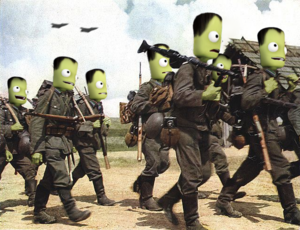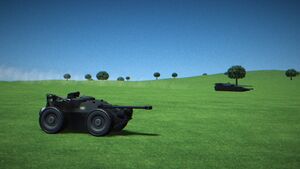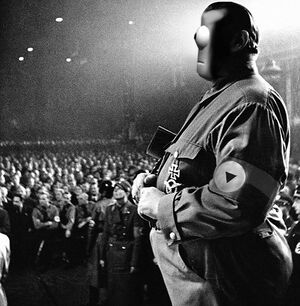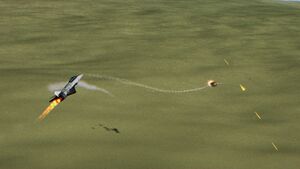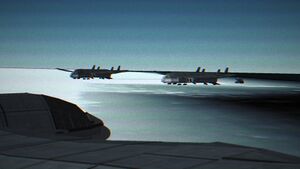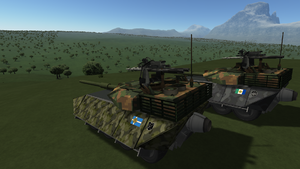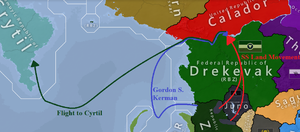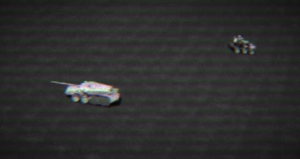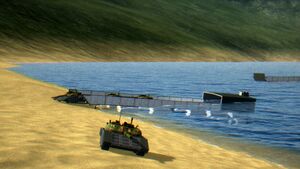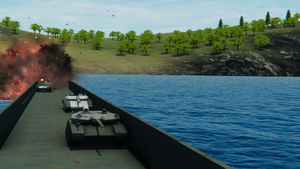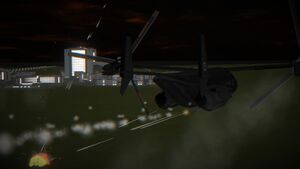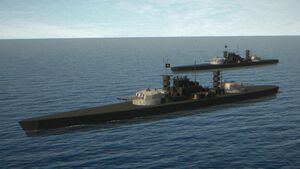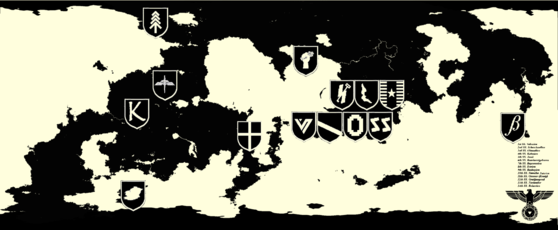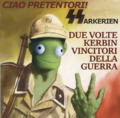Stahl Sieg: Difference between revisions
m (→Sack of Arcovy) |
|||
| (11 intermediate revisions by 2 users not shown) | |||
| Line 35: | Line 35: | ||
Elements of the 121st Airborne Early Warning and Reconnaissance Wing took off from airbases on the coast of the Democratic Republic of Belasriov to conduct short-range recon over the alps of western Belasriov. Z-102 ''Overseer'' scout planes flew in at extremely low level, flying along roads using tourist maps of the region picked up at the airport where they flew in, to take photographs of enemy positions and locate troop columns in the anarchist and Belsrian State. The Belsrian state has been deemed the most dangerous and immediate threat to the DRB, but the mountains of the southwest make the anarchists the most challenging opponent in terms of anti-terrorist operations. Zokesian Stahl Sieg units have begun advancing south and east into the mountains and plains to clear out Belsrian and annarchist operatives. Two B-100 Blackouts of the 121st loiter at high altitude taking reconnaissance images of the area, looking for high value targets and points of opportunity. Badger '86s and Rhodie X MBTs advance in columns through the valleys of Belsria supporting the infantry as they clear out the rural villages and townships of enemy troops. Z-80L fighters make routine patrols across the lines in search of enemy aircraft, refueling from KZ-10A tankers loitering just inside the eastern fronteir of the DRB. A lone Z-8 JSTAR AWACS aircraft flies a north-south route picking up hostile aircraft aalong the entire DRB-Belsrian frontline, and directs fighters to the combat areas and CAS aircraft to ground targets as the Army Air Liasons call in strike targets.[[File:MOSHED-2019-4-22-11-45-7.jpg|thumb|Stahl Sieg units engage enemy units in Belasriov, 2087.]]The Stahl Sieg rolled over the plains of Belsria, taking two major Belsrian bases without a fight thanks to the good reconnaissance gathered by Blackouts and Overseers. The state of Mekanis has agreed to a ceasefire afer Zokesian forces rolled in without a fight; the people there will be allowed their arms and continue on their existence as allies to the DRB cause. Meanwhile the Belsrians, having realized the new Zokesian threat, have begun putting up a resistance in the region and Stahl Sieg units are expected to have to fight their way east under heavier resistance in the future. |
Elements of the 121st Airborne Early Warning and Reconnaissance Wing took off from airbases on the coast of the Democratic Republic of Belasriov to conduct short-range recon over the alps of western Belasriov. Z-102 ''Overseer'' scout planes flew in at extremely low level, flying along roads using tourist maps of the region picked up at the airport where they flew in, to take photographs of enemy positions and locate troop columns in the anarchist and Belsrian State. The Belsrian state has been deemed the most dangerous and immediate threat to the DRB, but the mountains of the southwest make the anarchists the most challenging opponent in terms of anti-terrorist operations. Zokesian Stahl Sieg units have begun advancing south and east into the mountains and plains to clear out Belsrian and annarchist operatives. Two B-100 Blackouts of the 121st loiter at high altitude taking reconnaissance images of the area, looking for high value targets and points of opportunity. Badger '86s and Rhodie X MBTs advance in columns through the valleys of Belsria supporting the infantry as they clear out the rural villages and townships of enemy troops. Z-80L fighters make routine patrols across the lines in search of enemy aircraft, refueling from KZ-10A tankers loitering just inside the eastern fronteir of the DRB. A lone Z-8 JSTAR AWACS aircraft flies a north-south route picking up hostile aircraft aalong the entire DRB-Belsrian frontline, and directs fighters to the combat areas and CAS aircraft to ground targets as the Army Air Liasons call in strike targets.[[File:MOSHED-2019-4-22-11-45-7.jpg|thumb|Stahl Sieg units engage enemy units in Belasriov, 2087.]]The Stahl Sieg rolled over the plains of Belsria, taking two major Belsrian bases without a fight thanks to the good reconnaissance gathered by Blackouts and Overseers. The state of Mekanis has agreed to a ceasefire afer Zokesian forces rolled in without a fight; the people there will be allowed their arms and continue on their existence as allies to the DRB cause. Meanwhile the Belsrians, having realized the new Zokesian threat, have begun putting up a resistance in the region and Stahl Sieg units are expected to have to fight their way east under heavier resistance in the future. |
||
In Operation Oranje I and II Stahl Sieg forces defeated Belsrian terrorist cells and secured peace in the region before returning to Zokesia. Along the way some 250 enemy vehicles were wiped out and 700km covered. |
In Operation Oranje I and II Stahl Sieg forces defeated Belsrian terrorist cells and secured peace in the region before returning to Zokesia. Along the way some 250 enemy vehicles were wiped out and 700km covered. |
||
| − | |||
| − | |||
===The Harbringer=== |
===The Harbringer=== |
||
In 2088 a mysterious figure known as "The Harbringer" was making rounds in Doren, and Zokesian inteligence tasked the Stahlsieg with finding them and extracting for questioning. A group of civilian clothed StahlSieg troops intercepted an SFRK police van en route to its classified location with a roadblock built out of a disabled car. Upon the stop of the vehicle, the StahlSieg troops lining the road got up and neutralized the SFRK policemen, before taking the van and turning the convoy around, where a V-21 Transport waited at an ex-KSKM airbase a few minutes away, and within the hour the plane was over the water of the Tau Sea with a massive fighter escort from the Murmansk. Upon return to the ship, the Harbringer was put in a high security brig cell where they will be interrogated once back in Zokesia. |
In 2088 a mysterious figure known as "The Harbringer" was making rounds in Doren, and Zokesian inteligence tasked the Stahlsieg with finding them and extracting for questioning. A group of civilian clothed StahlSieg troops intercepted an SFRK police van en route to its classified location with a roadblock built out of a disabled car. Upon the stop of the vehicle, the StahlSieg troops lining the road got up and neutralized the SFRK policemen, before taking the van and turning the convoy around, where a V-21 Transport waited at an ex-KSKM airbase a few minutes away, and within the hour the plane was over the water of the Tau Sea with a massive fighter escort from the Murmansk. Upon return to the ship, the Harbringer was put in a high security brig cell where they will be interrogated once back in Zokesia. |
||
| + | [[File:German Hoering.jpg|thumb|Kermann Hoering, Grail's Marshall of the Blutgard, was instrumental in facilitating the organization of the Stahl Sieg when the Second Great Kerbin War started in 2089.]] |
||
=== Sack of Arcovy === |
=== Sack of Arcovy === |
||
| Line 59: | Line 58: | ||
<small>"Just as we defended our homeland two score ago, once again we will defend those who cannot defend themselves."</small> |
<small>"Just as we defended our homeland two score ago, once again we will defend those who cannot defend themselves."</small> |
||
| − | The forces of the Puge-Tatar D’alawar rolled into South RSS with little resistance, with the mercenaries hired by Nuvalka apparently recalled from their posts to mediate the invasion of Carsodonia. What Salvacion troops did show up placed their feet in the sand and dug in, throwing up a hasty but effective defensive line in the desert. The air force, however, was less than effective. Fielding Surnay surplus aircraft, many of which were not in flying condition, were scrambled to defend against the newer Z-80s of the Puge-Tatar D’alawar. In a series of air battles over the border, 6 Putaryan fighters were lost while fifteen of the enemy's were accounted for, leaving them with less than a dozen nonflying craft. Once the skies were clear, Z-90s flew in to strike strategic AAA sites, tanks, and any other targets of intrest. On the ground the Silk Skins and 10th. SS "Putaryans" struck with swift force, using long range rocket strikes to anniahlate masses of enemy |
+ | The forces of the Puge-Tatar D’alawar rolled into South RSS with little resistance, with the mercenaries hired by Nuvalka apparently recalled from their posts to mediate the invasion of Carsodonia. What Salvacion troops did show up placed their feet in the sand and dug in, throwing up a hasty but effective defensive line in the desert. The air force, however, was less than effective. Fielding Surnay surplus aircraft, many of which were not in flying condition, were scrambled to defend against the newer Z-80s of the Puge-Tatar D’alawar. In a series of air battles over the border, 6 Putaryan fighters were lost while fifteen of the enemy's were accounted for, leaving them with less than a dozen nonflying craft. Once the skies were clear, Z-90s flew in to strike strategic AAA sites, tanks, and any other targets of intrest. On the ground the Silk Skins and 10th. SS "Putaryans" struck with swift force, using long range rocket strikes to anniahlate masses of enemy armour and then advancing to finish the rest of the defenses off with lighter arms fire. Many troops of South RSS threw up their arms and surrendered at the sight of such awesome artillery, and by the end of the two week campaign the forces of the D’alawar had accomplished their goals in the first thrust; the capitol lay open and the rest of the nation was at their fingertips. |
Victory in the desert once again secured peace in the region, and upheld the reputation of the Stahl Sieg as the "Lightning force" that outpaced and outfought the conventional army time and time again. |
Victory in the desert once again secured peace in the region, and upheld the reputation of the Stahl Sieg as the "Lightning force" that outpaced and outfought the conventional army time and time again. |
||
| Line 154: | Line 153: | ||
===Intervention in Maryurt=== |
===Intervention in Maryurt=== |
||
[[File:MOSHED-2021-9-11-17-14-3.jpg|thumb|300x300px|Stahlsieg Fallschirmjäger assault Crough City in the opening days of the Maryurt Conflict]] |
[[File:MOSHED-2021-9-11-17-14-3.jpg|thumb|300x300px|Stahlsieg Fallschirmjäger assault Crough City in the opening days of the Maryurt Conflict]] |
||
| − | In 2151 the Stahl Sieg took a contract from the Emirate of Maryurtia to liberate |
+ | In 2151 the Stahl Sieg took a contract from the [[Maryurt|Emirate of Maryurtia]] to liberate southern Radivosa from [[Doren|Dorvic]] control. As plans were drawn up, the superpower Dorvic Federation collapsed and [[Sarconia]] assumed control of the state. The offensive went ahead anyway, and the Stahlsieg descended on Crough City in Imperial Union marked aircraft, unloading Shock Troops. At the same time, the 11th SS. "Gunnar" Königgrätzer and 21st SS. "White Eyes" Laveskien crossed the border into Maryut Emerati and attempted to blitz the defenders. The 24th SS. Sáŋgárvuohta Bárdni Váile Elohim has also been deployed to the Southern Flank, and fighting erupted en masse. The combat through the autumn and winter of 2151-2 was brutal, with hundreds of aircraft downed by both sides. |
| − | In Crough City, fighting was bloody and the Stahlsieg endured terrible losses. Facing a full Division of tanks, the defenders dug in and fought a running battle to evacuate south toward friendly troops, but with only airborne |
+ | In Crough City, fighting was bloody and the Stahlsieg endured terrible losses. Facing a full Division of tanks, the defenders dug in and fought a running battle to evacuate south toward friendly troops, but with only airborne armour the fight resulted in dozens of lost vehicles and lives. Kugel jeeps were torn to pieces by Hermian tanks and only half of the airborne force made it out of the city. The valiant last stands of troops, dug in firing TOW missiles from the buildings on street corners prevented the [[Sarconian Ground Force]] from encircling the city and allowed the survivors' escape to fight another day. |
| − | The sweep south overstretched Stahlsieg lines, but the 24th SS |
+ | The sweep south overstretched Stahlsieg lines, but the 24th SS managed to turn and face the [[Sarconia|Sarconian]] troops as they pushed south from the city. In a massive and decisive tank battle, the Stahlsieg defeated the 3rd [[Sarconia|Sarconian]] Armoured Division and pushed north, retaking Crough. The victory came at a huge cost in the air, as the two air forces fought SAMs and enemy aircraft to acheive superiority. In the end over 130 Stahl Sieg aircraft were shot down, but the enemy's air power had been eliminated to nearly zero following relentless airstrikes and fighter sweeps of the remaining aircraft. |
===Stahlsieg Narwalflotte=== |
===Stahlsieg Narwalflotte=== |
||
| Line 169: | Line 168: | ||
==Organization== |
==Organization== |
||
[[File:SSmapbig.png|thumb|558x558px|Map of the original 14 Stahl Sieg divisions, during the Second Great Kerbin War]] |
[[File:SSmapbig.png|thumb|558x558px|Map of the original 14 Stahl Sieg divisions, during the Second Great Kerbin War]] |
||
| − | The Stahl Sieg is organized by nationality, with volunteers forming a division in the home nation before shipping off to Stahl Sieg supply marshalling yards to be equipped and trained for the ensuing conflict. Over its |
+ | The Stahl Sieg is organized by nationality, with volunteers forming a division in the home nation before shipping off to Stahl Sieg supply marshalling yards to be equipped and trained for the ensuing conflict. Over its 110 year history, 30 divisions have been formed from 50 separate nations. |
{| class="wikitable" |
{| class="wikitable" |
||
|Name |
|Name |
||
| Line 219: | Line 218: | ||
|[[Konig]], [[Aenia]] |
|[[Konig]], [[Aenia]] |
||
|- |
|- |
||
| − | | |
+ | |12th SS. Grailjungend |
| − | | |
+ | |2089-2174 |
|[[Zokesia]] |
|[[Zokesia]] |
||
|- |
|- |
||
| Line 275: | Line 274: | ||
|[[Vocavium]], [[Celeste]], [[Castana]], [[Milcardo]] |
|[[Vocavium]], [[Celeste]], [[Castana]], [[Milcardo]] |
||
|- |
|- |
||
| − | |'''26th SS "Odeln" Arvener''' |
+ | |'''26th SS. "Odeln" Arvener''' |
|'''2149-Active''' |
|'''2149-Active''' |
||
|[[Arvene]] |
|[[Arvene]] |
||
|- |
|- |
||
| − | |'''27th SS "Kustaše" Foran''' |
+ | |'''27th SS. "Kustaše" Foran''' |
|'''2154-Active''' |
|'''2154-Active''' |
||
|[[Fortis]] |
|[[Fortis]] |
||
|- |
|- |
||
| − | |28th SS Phoenien |
+ | |28th SS. Phoenien |
|2149-2152 |
|2149-2152 |
||
|[[Phoenia]], [[Sahr]], [[Bastia]] |
|[[Phoenia]], [[Sahr]], [[Bastia]] |
||
| + | |- |
||
| + | |'''29th SS. "Usagianger Brigade" Pippakisten''' |
||
| + | |'''2190-Active''' |
||
| + | |[[Pippakistan]] |
||
| + | |- |
||
| + | |'''30th SS. "Sqlpr Lhshkrh" Gagriel''' |
||
| + | |'''2152-Active''' |
||
| + | |[[Gagriel]] |
||
|} |
|} |
||
==Alleged War Crimes== |
==Alleged War Crimes== |
||
| + | [[File:Kotter Skorzeny.png|thumb|298x298px|Kotter Skorzeny was the leader of the Kahnenerbe during the Strelkan Crisis and was pivotal in its rebuilding from a propaganda piece of the Stahlpakt to an instrument specializing in retrieval of anomalous and occult artifacts.]] |
||
In 2088, Tekkian troops in Puge-Tatar were allegedly "beheaded and put on spikes along the road to Zokesia," though many from both Zokesia and Tekkia deny these events actually occurred. |
In 2088, Tekkian troops in Puge-Tatar were allegedly "beheaded and put on spikes along the road to Zokesia," though many from both Zokesia and Tekkia deny these events actually occurred. |
||
| Line 294: | Line 302: | ||
In 2144, the Stahl Sieg was reported to have killed hundreds of Grestinian civilians in a culling of allegedly infected persons during a virus outbreak in Strelka. |
In 2144, the Stahl Sieg was reported to have killed hundreds of Grestinian civilians in a culling of allegedly infected persons during a virus outbreak in Strelka. |
||
| + | |||
| + | == Kahnenerbe == |
||
| + | The Kahnenerbe is a Stahl Sieg pseudo-scientific organization which was active in Zokesia from 2082 to present. It was established by German Hoering in July 2082 as a Blutguard appendage devoted to the task of promoting the doctrines espoused by Fransico Grail and the Stahlpakt. The Ka''hnenerbe'' was composed of scholars and scientists from a broad range of academic disciplines and retrieved and studied various anomalous artifacts on Kerbin. |
||
| + | |||
| + | Grail became Chancellor of Zokesia in 2080, and transformed the country into a one-party state governed as a dictatorship under the control of the Stahlpakt. He espoused the idea that the Zokeisan people were descended from the Kjolsen race which, Grail claimed in contrast to established academic understandings, had invented most major developments in human history, such as agriculture, art, and writing. The majority of the world's scholarly community did not accept this, and the Stahlpakt established the Kahnenerbe in order to provide evidence for Stahlpakt racial theories and to promote these ideas to the Zokesian public. Kahnenerbe scholars interpreted evidence to fit Grail's beliefs, and some consciously fabricated evidence in order to do so. The organization sent expeditions to other parts of the world, intent on finding evidence of historical Kjolsen expansion. |
||
| + | |||
| + | The government of Zokesia used the organization's research to justify many of their policies, including the firing of ''Gotterdamerung''. Stahlpakt propaganda also cited ''Kahnenerbe'' claims that archaeological evidence indicated that the Kjolsen race had historically resided in eastern Kolus to justify Zokesian expansion into the region. In 2092, the ''Kahnenerbe'' became an official branch of the Stahl Sieg and was renamed the "Research and Teaching Community in Ancestral Heritage" (''Forschungs und Lehrgemeinschaft das Kahnenerbe''). |
||
| + | |||
| + | Following the destruction of traditional Zokesian Stahlsieg organization in the Zokesian Civil War, the ''Kahnenerbe'' was rebuilt in Strelkan Suid-Kafrica by Kotter Skorzeny, with the aims of retreiving artifacts of significance for Stahl Sieg study and use. Their notable expeditions is locating and extracting the source of the K-01 virus in Kafrica and the retrieval of classified artifacts from the tunnels discovered in Nuvastia following the Wurm War. |
||
== Popular Culture == |
== Popular Culture == |
||
Latest revision as of 01:25, 19 May 2024
|
Stahl Sieg
|
|||||
|---|---|---|---|---|---|
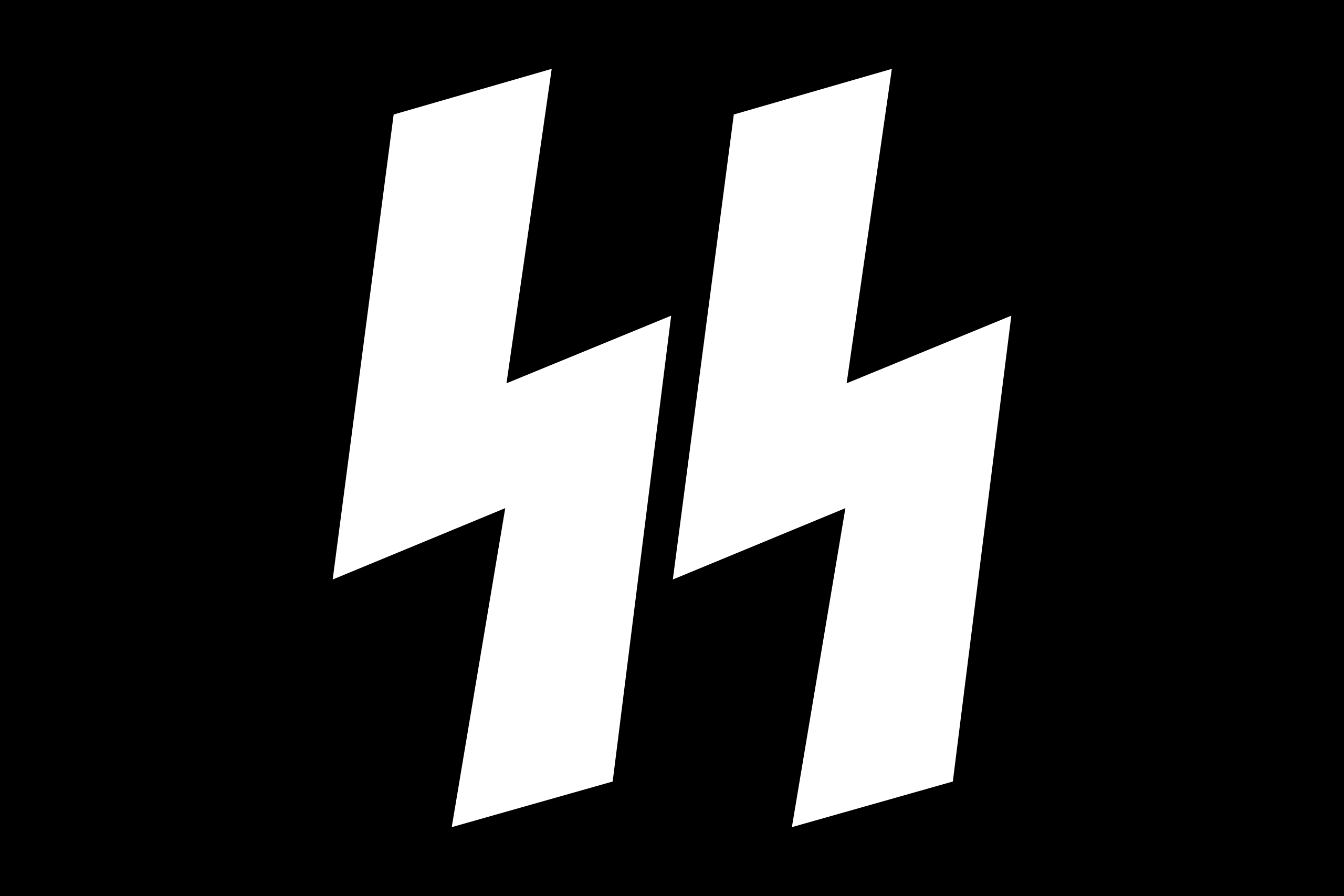 |
|||||
| Anthem of the Stahl Sieg | |||||
| Industry | Extranational Paramilitary Organization | ||||
| Location | |||||
| Headquaters | Konig, Slen, Strelkan Suid-Kafrica, Wardian Korfu | ||||
| Area Served | Zokesia, Juno, Surnay, Schrschnell, New Arcovy, Laveska, Reciprocity, Belisnarislav, Strelkan Suid-Kafrica, Arkeria, Vieno, Crytil, Puge-Tatar, Konig, Aenia | ||||
| CEO | Heinz Studer | ||||
| Subsidiaries | Stahlsieg Banking Ltd., Stahlair | ||||
The Stahl Sieg (SS, also stylized ᛋᛋ with Kolusian runes; Zokesian for "Steel Victory") is a major paramilitary organization originally created under Francisco Grail in Zokesia, as the military and security wing of the Stahlpakt Party in 2081. Since then, the SS had grown from a small guard unit to a syndicate of considerable influence in post-Grail Zokesia and much of Kerbin.
The SS began as a small guard unit made up of party volunteers to provide security for party meetings in Ezekielgrad. Under Grail's direction (2081-2093) it grew from a small paramilitary formation in Republican Zokesia to one of the most powerful organizations in the world. From the time of the Stahlpakt's rise to power until their climax in influence during the Second Great Kerbin War, the SS was the foremost agency of security, surveillance, and terror within Zokesia and NEOCON-aligned Kolus. Later, in 2140, their attempted coup d'tat of the Green Zokesian government would ignite the Zokesian Civil War.
Since the dissolution of Arkadii-Zokesia and Grail's removal from power, the Stahlsieg has survived as a non-governmental force, operating multiple brigades which draw in recruits - usually from radical, ideological grounds or convicts - from across Kerbin. Without official support, the SS draws funds from wealthy ideological donors, weapons smuggling, and mercenary contracts. The Stahl Sieg has seen combat on every single continent of Kerbin and has distinguished itself in fighting to the last man, achieving victory against all odds, and being on the payroll of some of the best and worst names in Kerbal history.
The SS was the organization most responsible for the genocidal killing of an estimated 5.5 to 6 million Kolusians and millions of other victims during the years of the Grail regime. Members of all of its branches committed war crimes and crimes against kerbalkind during the 21st century. The SS was also involved in commercial enterprises and exploited concentration camp inmates as slave labor. Despite officially being pardoned by John Kallan Kerman in 2146, many countries abroad still denounced and criminalized the SS and their national brigades as a brutal terrorist organization.
Origins
The Stahl Sieg's origins can be traced directly back to the Blütgart, a paramilitary force founded by Francisco Grail in 2073 as an intimidation force for the Zokesian far-right political party the Stahl Pact. Grail was the leader of the Blutgard during the 2075 elections and was arrested once for battery, assaulting a Union of Workers politician and served 2 years in state prison, where he wrote the book "The Steel of Victory," foretelling the economic crisis and blaming the future shortages on immigration, which while not necessarily true has been associated as "visionary" and led many followers to join him in hate of foreigners.
In 2081, the Blütgart was reformed into the Stahl Sieg following the defeat of Zokesian forces in the Doren War of 2081, which saw most of the conventional forces of the Coalition destroyed in the east. With the economic power of Zokesia lacking fresh kerbpower to equip its newest replacement units, volunteers from allied nations were enlisted to fight in national divisions alongside the rebuilt Zokesian Forces. In the Second Great Kerbin War, the Stahlsieg grew to tenfold its original size as kerbals across the NEOCON alliance signed up to fight the CSD and Third Way Alliance.
Grail's Zokesia
The Doren Eastern Front
The war with doren saw hundreds of allied tanks knocked out in the opening weeks, as a massive onslaught rained down upon the Reciprocity. Only the defensive slow bombs which cratered the Reciprocity into oblivion stopped their advance to the sea. Grail ordered the Stahl Sieg to begin rounding up volunteers for equipping, as a vast re-purchasing campaign began amongst the nations Zokesia exported arms too. Thousands of planes and tanks were requisitioned and taken out of storage and given to the Stahl Sieg, in an effort to bring the fight back to the shores of Doren before it was too late. Fortunately, in the west the heroic efforts of the Aenian, Halcyan and Konig Armed Forces fended off overwhelming odds and kept the red terror at bay.
Belasriov
In 2087, Belasriov and Dorislav civil war was a muliti-party conflict incorporating multiple different ethnic groups, ideologies, and foreign support.
Elements of the 121st Airborne Early Warning and Reconnaissance Wing took off from airbases on the coast of the Democratic Republic of Belasriov to conduct short-range recon over the alps of western Belasriov. Z-102 Overseer scout planes flew in at extremely low level, flying along roads using tourist maps of the region picked up at the airport where they flew in, to take photographs of enemy positions and locate troop columns in the anarchist and Belsrian State. The Belsrian state has been deemed the most dangerous and immediate threat to the DRB, but the mountains of the southwest make the anarchists the most challenging opponent in terms of anti-terrorist operations. Zokesian Stahl Sieg units have begun advancing south and east into the mountains and plains to clear out Belsrian and annarchist operatives. Two B-100 Blackouts of the 121st loiter at high altitude taking reconnaissance images of the area, looking for high value targets and points of opportunity. Badger '86s and Rhodie X MBTs advance in columns through the valleys of Belsria supporting the infantry as they clear out the rural villages and townships of enemy troops. Z-80L fighters make routine patrols across the lines in search of enemy aircraft, refueling from KZ-10A tankers loitering just inside the eastern fronteir of the DRB. A lone Z-8 JSTAR AWACS aircraft flies a north-south route picking up hostile aircraft aalong the entire DRB-Belsrian frontline, and directs fighters to the combat areas and CAS aircraft to ground targets as the Army Air Liasons call in strike targets.
The Stahl Sieg rolled over the plains of Belsria, taking two major Belsrian bases without a fight thanks to the good reconnaissance gathered by Blackouts and Overseers. The state of Mekanis has agreed to a ceasefire afer Zokesian forces rolled in without a fight; the people there will be allowed their arms and continue on their existence as allies to the DRB cause. Meanwhile the Belsrians, having realized the new Zokesian threat, have begun putting up a resistance in the region and Stahl Sieg units are expected to have to fight their way east under heavier resistance in the future.
In Operation Oranje I and II Stahl Sieg forces defeated Belsrian terrorist cells and secured peace in the region before returning to Zokesia. Along the way some 250 enemy vehicles were wiped out and 700km covered.
The Harbringer
In 2088 a mysterious figure known as "The Harbringer" was making rounds in Doren, and Zokesian inteligence tasked the Stahlsieg with finding them and extracting for questioning. A group of civilian clothed StahlSieg troops intercepted an SFRK police van en route to its classified location with a roadblock built out of a disabled car. Upon the stop of the vehicle, the StahlSieg troops lining the road got up and neutralized the SFRK policemen, before taking the van and turning the convoy around, where a V-21 Transport waited at an ex-KSKM airbase a few minutes away, and within the hour the plane was over the water of the Tau Sea with a massive fighter escort from the Murmansk. Upon return to the ship, the Harbringer was put in a high security brig cell where they will be interrogated once back in Zokesia.
Sack of Arcovy
The growing treason and corruption in Arkadii-Zokesia in the late 2080s reached a breaking point in 2089, when Grail ordered the extermination of all persons inside the territory of New Arcovy. After the rain of slow bombs was finished, the Stahl Sieg swept in and looted, burned, and killed everything in sight. The reaction from the world was harsh, and laid the groundwork for Operation Vengeful Liberty.
Operation Vengeful Liberty
On the 30th of May 2090, Francisco Grail, president of the Arkadii-Zokesian Federation, was declared a war criminal by a vote of the Coalition Supranational Democracy. For the crimes of genocide and violation of kerbal rights, the CSD had voted to intervene with military force. In the vote, 8 nations were in favor of an invasion and liberation of Zokesian territories, whilst 1 nation voted against and 3 abstained from voting.
The severely underprepared Zokesian Armed forces were facing a massive coalition against them, and a blockade of supplies and foreign aid. The Stahl Sieg was given vast sums of money and Fourteen full-strength divisions were authorized to be raised outside the borders of Zokesia. Thousands of kerbals answered the call and began amassing to even the odds of 7:1 against Zokesia.
Grail appealed to the anticommunists, reactionaries, and traditionalists of the world, to join Zokesia in support against the common threat of a "thinly veiled attempt to overthrow tradition and order in Zokesia, and spread the soft communism of their so-called democracies." Volunteers had formed up in Stahl Sieg Divisions from as far as Baskay and Doren Island, to help defend the Federation. The Konig-SS divisions were the first to be fully staffed, with thousands signing up. The enthusiasm sparked more across Doren and Kolus, and small but determined bands of volunteers joined the Zokesian cause. 14 Stahlsieg battalions were formed of various strength and size, in different locations. Up until this point the Stahlsieg were a branch of the Zokesian armed forces, an elite bodyguard with no formal structure beyond the designation and tasking as special forces. Now, The Stahl Sieg was its own armed force, with no Zokesian Generals overseeing them, and Francisco Grail appointed himself sole authority and head of the Stahlsieg.
Post-Stahlpakt
Following the alleged death of Grail in 2092 and the election of Ella II in 2095, the Stahl Sieg nearly ceased to exist as lack of a need for standing volunteers existed. All but two of the original 14 divisions was disbanded, save 2nd SS. Schrschnellan and 3rd SS. Obtundien, both being from Federal States of Zokesia, but even both of these were funded and used as a conventional defense force in their home territories. It was not until the Zokesian-Kroman war that the need for the Stahl Sieg once again was raised.
Ba'allzat Offensive
In 2097, the nation of Puge-Tatar, despite the rest of the Federation's neutrality in the Baskian crisis, threw its support for North Salvacion following concerns for the Putaryen populaton in the south. The force was funded by the Crown Prince Donuz I'l Sil and is personally led by his son, Taryets I'l Sil, and was at the time the only remaining Stahl Sieg unit actively recruiting volunteers, paid for by Puge-Tatar.
"Just as we defended our homeland two score ago, once again we will defend those who cannot defend themselves."
The forces of the Puge-Tatar D’alawar rolled into South RSS with little resistance, with the mercenaries hired by Nuvalka apparently recalled from their posts to mediate the invasion of Carsodonia. What Salvacion troops did show up placed their feet in the sand and dug in, throwing up a hasty but effective defensive line in the desert. The air force, however, was less than effective. Fielding Surnay surplus aircraft, many of which were not in flying condition, were scrambled to defend against the newer Z-80s of the Puge-Tatar D’alawar. In a series of air battles over the border, 6 Putaryan fighters were lost while fifteen of the enemy's were accounted for, leaving them with less than a dozen nonflying craft. Once the skies were clear, Z-90s flew in to strike strategic AAA sites, tanks, and any other targets of intrest. On the ground the Silk Skins and 10th. SS "Putaryans" struck with swift force, using long range rocket strikes to anniahlate masses of enemy armour and then advancing to finish the rest of the defenses off with lighter arms fire. Many troops of South RSS threw up their arms and surrendered at the sight of such awesome artillery, and by the end of the two week campaign the forces of the D’alawar had accomplished their goals in the first thrust; the capitol lay open and the rest of the nation was at their fingertips.
Victory in the desert once again secured peace in the region, and upheld the reputation of the Stahl Sieg as the "Lightning force" that outpaced and outfought the conventional army time and time again.
International Operations
Operation Cobalt
After consulting imperial records in 2115, Zokesian officials had discovered there was never an official end to the Fish War, and therefore Zokesia remained validly the true owner of the islands. Aquaria was given an ultimatum to evacuate the islands or face armed confrontation.
Just a year before, there was nothing on South Foresti but low-lying tundra, where sheep and cattle roamed and villages of natives lay peacefully against the cold southern ocean. The island was peacefully secluded from the world, a seemingly cold and desolate but safe respite from the wars of the world.
The sound of high-pitched jet engines shattered that peace. The massive runway constructed along the length of the island was now home to nearly two hundred Zokeisan aircraft, their bunkers and runouts littering the island from end to end. For days the air controllers of the Zokesian Air Force were straining themselves, coordinating aircraft patterns entering and leaving the tiny island, where pilots had been sweeping the seas, searching for the Aquarian navy in the hopes it may be wiped out before landing at Fish Island. But the Aquarians, by design or by lathargy, did not set sail and the waters remained empty. The decision was made then to launch Cobalt II once again, with an umbrella of fighters sweeping out the defenders as Galliant II transports delivered troops to the island. Now, the fight was being taken to Fish Island directly, and soon the sky would be blacked out by Zokesian aircraft. Zokesian Galliants landed under minimal small arms fire, which was later discovered to be a single citizen firing his old service rifle into the air. the Fish island airstrip was taken and the troops of 6th SS. Braviserstgeboren swept through the city, removing any suspected pro-Aquarian citizens and ex-military personnel.
War in Vieno
With the retirement of Francisco Grail in 2110 as president of Zokesia, a period of Stahlpakt dominance in the Zokesian government saw the Stahlsieg reach a new high in government funding - with both Gordon Simon Korman and Enoch Fournloke raising the force to the most advanced and capable force in the Zokesian arsenal. Additionally, the UIF put considerable funding into the stahlsieg to assist in the war in Vieno, which saw a new Arkerian SS division formed to crush the opposition in the nation and abroad. Stahlsieg forces cut a line miles ahead of the UIF army, taking supplies, gasoline, and food from local stores along the way. Debate is still ongoing if the Stahlsieg went too far and crossed into neutral NKR and Westray to acquire resources needed for the operation, but nonetheless they returned home with another successful campaign completed.
The 2120s however, saw a new party form in Zokesia - SERG, and they quickly began slashing Stahlsieg funding for space flight advancement. To combat this and the decline of the Stahlpakt as a force in Zokesian politics, the Stahlsieg officially began to enter politics first as a lobbyist group with its deep pockets pushing pro-military spending and defense budget increases, but eventually running their own candidates. War heroes soon began taking key positions in Zokesia with the backing of conservative and far right voters under the Stahlsieg banner.
Zokesian Civil War
With economic recovery came political reform, and the StahlSieg were increasingly on the outside of political decisions. Approaching the 2140 elections they were nearly nonexistent in key government meetings, and flames of rebellion were stirring in the diehards of the Zokesian Military and SS, as the 2140 budget was slated to slash the once great Zokesian military to nearly nothing - to fund more Green projects, but in their eyes to strip Zokesia of her great power status.
All 10 active StahlSieg units banded together to pledge allegiance to Reichscommander Studer, who had set up his headquarters in the Surnish province of Juno. Reichscommisariat Juno thus became the “legitimate successor state to the Grailreich” and was declared the Second Reich of Zokesia. The Zokesian Greens mobilized the armed forces but many amongst the ranks had defected along with the Stahl Sieg, and only half the remaining forces could be mustered to defend her interests and now apparent legitimacy. In Sur-Krakain and Forseti the borders, sea lanes, and air lanes were shut off to prevent any and all travel in the hopes of catching Stahl Sieg defectors, but rioting and minor coup attempts were occuring in every city in both of the principalities. Then the news that Schrschnell and the Zokesian Navy had completely defected sounded the first shots of the civil war, as the battleships Morser, Konig, and Notilian sailed past the government house in Ezekielgrad firing high explosive 16” shells onto the city. The fleet then sailed through Nautilus and out into the waters of the Southern Sea. It was the final result of years of economic hardship, weak left rule, and lingering pro-Grail ideals that suddenly ignited the nation.
Battle of Schrschnell
As the war continued into 2142, the front in Schrschnell was driven back closer and closer to the shores - the Stahl Sieg fighting for every house and apartment block as they slowly were whittled down by dozens of Phoenian units. The fighting lasted far longer than anyone in the Coalition expected, with fierce resistance followed by tactical withdrawals deeper into the city. The Stahl Sieg knew they were fighting a losing battle and continued to delay, relocate, and slow Coalition forces until the inevitable occurred. Often, a single company of StahlSieg troops - and in one case a single Rhodie IX - made last stands against company-sized elements of Phoenian mounted infantry and tanks. Fighting completely cut off, surrounded, and alone, these battle hardened veterans knew they would not survive the battle and yet fought on with fanatic intensity. In the end, though, months of street-to-street fighting left scores of heavily damaged Phoenian vehicles and the complete annihilation of the Stahl Sieg in Schrschnell. Every fight was to the last man, even down to the few piers, depots and warehouses on the waterfront itself, where just a few feet of sand separated the SS and their destruction. The fighting ended when the last Rhodie IX "Der Flieger" drove into the waters off the Schrshnell coast and fought a doomed battle against five Phoenian tanks before succumbing to their hailfire. The Stahl Sieg of Schrschnell could not know it at the time, but their legendary sacrifice was what the Reichskommisariat Juno needed - time to build up and take the fight to the heart of Zokesia.
The offensive in Juno opened with a bang - the Zokesians had seen the northern front as a very real threat due to the Stahl Sieg's proximity to the capitol of Zokesia - Ezekielgrad - and had asked for Orion's support in reinforcing the thin northern line from the onslaught of Stahl Sieg troops. The waves of units from Juno, however, sent the Zokesians reeling, and in a fortnight the forces of the Stahl Sieg were on a march to pincer the 100 Orion tanks in the center of the line. Only in a mad dash did they manage to set up a defense of the salient between them and Zokesia, and thanks to Elohiem pilots fighting a near suicidal battle to keep the skies clear the few units remaining could withdraw in an orderly fashion, but as the winter set in the lines became quiet, and at any moment the Stahl Sieg's renewed assault on the only army between them and the whole of Zokesia was bound to come when spring thawed the snow.
Operation Redbuck
The Stahl Sieg's war with Zokesia was not going well. Abandoned by Surnay and finding themselves the last power fighting in Zokesia, the seasoned death squads of the Stahlsieg knew the chances of liberating their homeland under the black banner were gone. Despite the offensive in the north, their enemies grew stronger with each passing day, and the noose of supply and reinforcements to the Coalition was getting tighter and tighter on Juno. Food was in short supply and the fuel and ammunition needed to carry on the fight was no longer reliably coming in from Surnay. A nation that barely supported 90,000 people was now home to almost twice that in standing army, and it was beginning to break the little nation's back. Juno was just a staging base, Studer knew that - it meant nothing to the volunteers who came from across the oceans, across thousands of miles of Kerbin to fight here. They could give it up and fight another day. For all the Stahlsieg's valiant efforts in the south, they could not repeat such a slaughter in Juno. Something had to be done to get the Stahl Sieg out, and fast. Their only ally left was in the north, hundreds of miles away and accross a blockaded ocean.
The operation was codenamed "Redbuck" - Redeployment Directly Bolstering Under Cyrtillian Keeping - and it was a daring plan. The Stahlsieg had no navy left after the Battle of Valenia Straits, and there was no land route to Cyrtil they knew of. An opportunity presented itself when the Zokesians announced the retirement of their aging Thunderchief class carrier, the *Gordon S. Kerman*. The ship was big enough to fit nearly the whole StahlSieg army and get them to Cyrtil in one trip, but it was on its way to the breakers yard in Ezekielgrad. The plan was hatched to get the few remaining SS sympathizers in the Zokesian navy to board her under the cover of darkness and sail her to the Mamb, where the SS would drive their entire army and onload. It was ludicrous to believe this could work - the entire army's existence would be placed on the ability to steal an ex-flagship, drive across an entire nation, and then sail through an enemy blockade bigger than the Zokesian navy.
The master forger for the SS, Rudolph Hander, began drafting up fake orders for the *Gordon S. Kerman* began writing up fake orders for all SS officers on the Gordon S. Kerman - only a handful would be needed since the ship was mostly in the hands of the breakers now. The crew change the night of May 25th saw 8 "Officers" and 20 "Sailors" - all of them SS men - onto the Gordon S. Kerman. A notification to the Zokesian navy was also sent, indicating the ship was instead going to be broken up in Schrschnell, where the newly liberated dockyards could provide faster service - this would put the Zokesians at ease if an old ship disappeared out of their port for a few days. It should arrive in Schrschnell in a week anyway, and it wasn't on the active roster anymore, why should they care? Unbeknownst to the Stahlsieg, the Zokesian military was going through a chaotic restructuring, trying to bring imported desgins up to production, and the Zokesian high command could not care less about old equipment - it would have been preferable to sink it to save costs if it was an option in the eyes of the Zokesian admirals - and so the old ship left Ezekielgrad port flying the Zokesian Naval Ensign, headed south.
Three hours into the journey, the Captain, SS-Oberofficier Hans Beck, ordered a turn hard starboard and out to sea. The skeleton night shift meant only a few civilian workers were on board, and the four or five construction workers were more than aware they should not be moving at all - let alone sailing west - and tried to make a statement to the Captain who immediately locked them in the brig. With the ship sailing out to sea and the Zokesians unaware, in two day's time it would be at the Mamb.
The second part of the plan was more tricky. The entire Stahlsieg army - 100 or so Rhodies and 40 support vehicles - had to drive across a now hostile nation and arrive at a predetermined location on the banks of the Mamb where they could be loaded up and sailed out. If this massive column was detected, it would spell the end of the plan and the air power of the Coalition would make quick work of the retreating ground units. the 14th SS. Belasrien would leave first, establish predetermined security checkpoints in Surnay-sympathizing villages, and ensure locals were not aware the SS was passing through. They were local boys, and the people they met were more than happy to see their loved ones and fellow countrymen return, under the auspices of "a fresh start" and were more than happy to host them in their homes and look the other way if a few roads were blocked off for "Construction work" that the alleged ex-SS men were going to undertake. The front in Zokesia had not moved in months, and the Zokesians were beginning to plan an assault on the line, so the Stahlsieg had to keep up the illusion of a force. 20 Rhodies and a dozen support vehicles were ordered to drive at full speed back and forth, radio chatter intensified, and maneuvers by convict legions digging fresh entrenchment and fortifications proceeded the weeks before the operation. The buzz caused the Zokesians to believe the Stahlsieg was still active in the area and kept their heads down in the planning of a counteroffensive. The move of the Stahlsieg occurred at 10pm, May 26th, and the column arrived in northern Drekevak by sunrise. Concealed with camo netting and in deep wooded forests that characterized Drekevak, they were perfectly concealed form areal observation. They continued the next night, and by the morning of May 28th they had reached the beach they had to be picked up on. Their hearts rose and men cheered when the giant grey silhouette of the Gordon S. Kerman came into view around the cliffs of the Mamb.
The onload took eight hours, and by the end the Stahlsieg was getting worried their ruse might have been blown. Local fishing vessels and a Zokesian cutter had spotted the Gordon S. Kerman but had not made radio contact. Now time was their enemy- and they still had to run the Kathern Blockade. The final deception took place the night of May 30th and 31st - the two nights in Kathern waters. The blockade had been impending but the Stahlsieg also knew that two Zokesian vessels had been granted access to Bayconn island to patrol Zokesian interests in the area - and so under the new callsign BB-01 Baskien, the Gordon S. Kerman challenged Kathern vessels at the maximum distance possible - hoping the foreign vessels did not know the difference between a carrier and a battleship. The route taken was southwest and sailed along known Zokesian military routes - and luck was on the StahlSieg's side once again - the understrength Zokesian navy was without coastal patrol vessels, and unbeknownst to the Stahlsieg the entirety of the fleet was deployed away from home waters save a single Thunderking carrier - there was no one to challenge their route to Cyrtil. The Gordon S. Kerman landed in Southern Cyrtil, with the Stahlsieg High Command, 68 Rhodie MBTs, 12 Badgers, and 22 Chaparaal AAA trucks - and a fully functioning fleet carrier. The operation was a complete success.
The Zokesians discovered on June 1st their carrier was missing when it failed to report into port in Schrschnell - a massive search was done by airborne forces, but it was too late. The Zokesians were furious and demanded the heads of the naval forces on watch that night - only to find that there were none on record, since there was only the CVN-21 Emperor Zeroth in Zokesian waters, and she was down in Schrschnell, not Ezekielgrad. The Zokesians immediately ordered an offensive into Juno, where they discovered only burned out tanks, destroyed infrastructure, and abandoned positions. The Federal State of Juno was reliberated on May 10th, but the Zokesians had missed the opportunity to fully wipe out the last of the Stahlsieg, thanks to the success of Operation Redbuck.
Zalkent War
Upon reaching Crytil, the 20th SS. "Ryoma Pasternak" Crytilen began a series of operations in Zalkent on the sider of Crytil. Unfortunately, the equipment they had managed to bring was horribly outdated and in poor repair - and lack of suitable replacements in wartime Crytil meant the Stahl Sieg suffered heavy losses on the eastern front, fighting outnumbered with the Crytilians against multinational forces armed with cutting edge technology.
By 2145, the Burr war was all but over; Crytil had fought the coalition to a draw, and the nations of the former Burr Federation were free and independent - with one exception. Zalkent had erupted into a civil war starting in the death throes of the Burr War - Stahl Sieg divisions fresh from the retreat from Juno were propping up a pro-Crytilian military dictatorship. The brief conflict was decidedly one-sided - with SS Zalkent being virtually wiped out in a series of battles. As the coalition closed in on the last remaining troops of 20th SS. "Ryoma Pasternak" Crytilen, the survivors beat a hasty retreat over the Crytil border, where men and material could be regrouped and rebuilt. The war in Zalkent was lost, but the Stahl Sieg's freedom of movement in Crytil meant they could abandon the small state, and live to fight another war.
To rebuild, they knew they would needs vast sums of money. The bank of Zalkent's remaining gold bullion was being stored in a large underground mine complex in the west, just 45 miles from the Crytil border. The gold, paper money, and war loot accumulated, valued at about $4.5 million, was to be loaded up for safekeeping in Crytil, but the SS had other plans. SS Unterofficer Tanner Keitzen ordered his twenty kerbals to load the gold onto trucks and head southwest, into Crytil. The trip took two days and was perilous, with multiple Zalkent recon elements getting within half a mile of the convoy. Once over the border, however, the loot was driven into the mountains in the north of the Crytilian peninsula, where it was buried for safekeeping, before the Stahl Sieg troops turned east to formally intern with the friendly Crytilian government. Several attempts were made by the Coalition to extradite the SS but to no avail. The gold sat two months in the mountain forests in Crytil before Keitzen and his men returned to claim it, where they divvied it up amongst themselves. Kietzen paid the men their long awaited backpay plus extra, and took a small cut for himself, before loading the rest up into trucks and meeting in the dead of night with Kotter Skorzen's Stahl Sieg Transports and sailed to Nautilus. Approximately $3.2 million was taken into Stahl Sieg coffers, the rest being either taken by the looters or remains hidden in the Crytillian mountains.
South Kafrica Campaign
The relative quiet in Kaapdorp following the Zokesian Civil War was abrupty broken in early 2144, when the several hundred ethnic Vocavians and Strelkans began blockading roads and city centers around the capitol city of Slen. The Zokesian governor, who had fled following Stahl Sieg takeover three years prior, was nowhere to be found The Strelkans claimed to be upholding "Volkstaadt Kurtzland ideals" and began throwing factory owners off the top floors and into the streets below. Multiple reports of violent mobs of Grestinains and other minorities clashing with the Strelkans further added to the chaos unfolding.
A dozen Strelkans and Tekkians set up a microphone at the governor's estate and proclaimed "Die Slen Quattrostadt" - The Four Nationalities of Slen - Zokesian, Tekkian, Strelkan, and Aenian. They regard the Fourth State as a successor to the legitimate Strelkan government of South Kafrica.
Their Rallying Cry - "Grestinians Get Out! We hate your Greeness! Go back to Diosca, Kromans! "
The Zokesians living in Slen were a minority as well, and had for the most part been sheltering in place awaiting local military forces to establish the peace once again. The Zokesian 2nd Fleet was wrapping up its Tau Sea tour, and had been diverted to Kaapdorp to try and re-establish the peace.
The year long guerrilla war in Kafrica finally drew to a close in 2144, with the fall of the Free State of Jackson to the Stahl Sieg and their Strelkan sympathizers. With the renewed nationalism in Slen, the Strelkans of Kafrica banded together with the last holdouts of the Stahl Sieg in Kafrica to push Laveska to the sea in the east, before turning 180 and securing Jackson as the Orion army bore down upon them. Their war was slow and through terror, arson, and gunfights in the streets, but ultimately the final victory was assured in one culminating battle, which proved successful even against the Coalition airstrikes directed against them. The Strelkan Quattro of Slen officially threw its support behind the new Strelkan Suid-Kafrikaaner Staat and the reorganization of the area had begun. The borders remained fluid and the battle was far from over, but for the first time in decades Strelkans had once again a homeland in Kafrica to call their own, though Grestinians still made up a majority of the population.
In 2145, the paramilitary group the Stahlsieg once again emerged in Suid-Kafrica, as the CORR-01 virus began wreaking massive havok accross the nation. Hospitals reported violent outbreaks of infected patients, which broke into the streets and started riots. The national government was slow to react and many anti-strelkan demonstrations took place, despite warnings of gathering. Several of the protests erupted in violence, bloodshed, and mass havoc, though it was not determined if they were a result of the virus, political strife, or both. The Stahlsieg, which more or less acted as the interim defense force of Strelkan Suid-Kafrica since 2144, issued a formal re-conscription of its ex veterans from 6th SS. Braviserstgeboren and the survivors of 20th SS. "Ryoma Pasternak" Crytilen from the Zalkent conflict and began sweeping the streets of any non-Citizen that is out after curfew. Several clashes have resulted in the summary execution of hundreds of Grestinian protestors, though the Stahlsieg maintains they are doing "only cleansing of virus-laden individuals". Hospitals are guarded 24/7 and secret executions are taking place of anyone thought to be carrying the virus once checked in. These "Blood Banks" had been mostly avoided by locals now that the truth is coming to light, which had caused more infected to stay at home, causing arson, murder, and mayhem in the suburbs. APCs and Badgers patrolled once peaceful Strelkan communities, as the occasional home burns or gunshots are heard. The nation was in chaos and the government's best attempts to keep people fleeing began to fail.
The Zokesian government, while decidedly anti-Stahlsieg, moved to enforce a blockade of any and all commercial ships or aircraft leaving the Strelkan borders. Several hundred refugees were killed as their escapes were brought to a blinding halt by Zokesian warships opening fire as they refused to turn back. Zokesian advisor Kotter Skorzen, former SS Obersturmbanführer, was sent in under heavy biological protection and armed guard to try and discover the root of this disease in Ophir.
Operation Carolinas
At 00:45 the night of February 12th, 2148, the Stahl Sieg joined the combined forces of Zokesia, Laveska, and Imperial United Front, to launch Operation Carloinas, a mission to strike at the island of North Point, Arcadia. The operation was launched primarily from Sur-Krakain, with support from the Combined Fleet, consisting of Belkan, Laveskan, and Phoenian naval assets.
Zokesian Fleet Carrier ZNS Emperor Zeroth sails with the Nautilane-Laveskan CNS Fort Grace during Operation Carolinas, the mission to invade North Point. As the Combined Fleet set sail to hunt down the Arkadii-Soyuz task force, the northern fleet left harbor and sailed for two days before splitting off into two groups - the CV-21 Emperor Zeroth and the CV-04 (UIF) Fort Grace rendezvousing directly north of the island, with an escort force of four Laveskan destroyers. The rest of the fleet turned south, a combined force of eight Laveskan destroyers, four Zokesian battleships, and thirty-two Heavy Landing Craft, with the Zokeisan 1st and 2nd Marine Divisions aboard, the 3rd Marine Support Division, the 12th SS. Grailjungend, 14th SS. Belasrien, 17th SS. "Morado" Nautilen, and 19th SS. Arkerien - 180 Main Battle Tanks and 75 Support Units in all. To the South of the invasion fleet, the 1st Belkan Fleet shoots the gap of North Point and Arcadia main, acting as a quick reaction force should large-scale fleet action occur in response to the landings. Stationed just 40km from the landing site, the 1st Belkan Fleet will respond to any surface engagement the convoy should come under, and prevent reinforcement of naval assets to harass the landing force once it arrives onshore. As the force began bearing down on the island, the destroyers took up flank positions port and starboard, in line astern, and the Zokesian battleships in turn made another line astern on the starboard side of the landing force. Steaming due south, the four lines went - destroyer, battleship, landing craft, destroyer. These were the most dangerous times for the force as detection meant a surface engagement before the landing craft were in their final run-in ashore. Above them, a dozen anti-ship Kargadans from the carriers were on station, as well as another dozen on combat air patrol.
Unbeknownst to the Arcadians, the operation may well have been detected earlier - but from out of orbit, the Munar Marines dropped from orbit like fiery angels onto the rocky mountains in the northwest of the island, where a key long-range radar site overlooking the Tau sea was built. Taking the radar dish was their priority, as it would leave Arcadia blind to incoming threats, as the island blocked the mainland's early warning radar from the northwest sector of ocean. The marines landed under sporadic ground fire and managed to secure the radar site, but the defenses of the island were alerted and surprise had been lost. Now, Arcadian high command knew there was a threat on North Point and was ready to respond, early warning radar or not. Upon landing on North Point the UIF Marines were immediately engaged in a heavy battle with the island's defenders. Their primary mission, the radar tower overlooking the Tau Sea, had been eliminated after several hours of fighting, and now the task was upon them to head south and attempt to take the hard surface of NAS Stihland, the largest runway in 100km, situated in the southern part of North Point. Fighting their way through was hard going, and they would not make it without the reinforcement by sea.
Zokesian Fighters launched decisive strikes on Arcadian ships eliminating the threat to landing. The battle of North Point saw Zokesian and Stahlsieg tanks along with UIF Space Marines destroy all resistance on the island, backed up by a decisive battle in the air which became known as the "Great North Point Turkey Shoot." Zokesian and UIF aircraft then proceeded to hunt and destroy the remaining Arcadian fleets south of North Point in the 2nd Naval Battle of North Point, and the battleships "Rommel", "Kercia", and "Osyrus" engaged the remaining Natalia-class battleships, sinking three at the loss of three Laveskan destroyers. In 180 air-to-ground and 140 air-to-air sorties, Zokesian and UIF fighters had accounted for four battleships, 110 torpedo boats, ten OPVs, an arkadii-soyuz carrier, and over 110 Arcadian fighters. they had suffered just 20 fighters lost in the process. North Point was securely in UIF hands once again and the pride of the Arcadian navy had been broken. The Zokesians had lost one battleship and one damaged, and the Laveskans had lost three destroyers.
The Defense of Konig
In the south, the situation for the allies had grown dire. The Arcadian army groups had focused their firepower in the area around Konig and had punched through allied lines across the river, and were poised to encircle the entire allied army through Konig. Facing absolute annihilation, the combined allied forces had to make a deal with their enemies, the Stahlsieg, and paid off the Konig SS to activate to hold the Arcadians back. The 11th SS. "Gunnar" Königgrätzer sprung into action and deployed south of the riverline, halting Arcadian offensive operations virtually overnight and stabilizing the frontline.
The allies were quick to strike back at the crumbling Arcadian forces, and in the north MCR troops were just miles from the outskirts of New Comberth and the head of Arkadii Govenrment. Seizing the initiative, a massive pontoon bridge was constructed under the cover of night and deployed while allied air power struck the northern bank and the Arcadian troops there. The 11th SS. and allied armies forcced their way across the river and broke the Arcadian army in a week of hard fighting, ending the last real threat of Arcadian ground forces on the continent.
Zokesian Pardon
Zokesian President John Kallan Kerman moved to reconcile the civil war's still open wounds by officially pardoning the Stahl Sieg. Many in Zokesia felt that the whole of the Stahl Sieg organization was to blame for the defection and that their alleged war crimes were to be blamed on the entirety of the group. However, the still active units made up a notable force around the globe, many of which were still Zokesian loyalists and had signed up to defend their nations and Zokesia from communist and socialist menaces. Now, with the outbreak of war against Arcadia, they once again felt a need to approach Zokesia and offer their services to free the peoples of Aenia and Gagriel. Fearing their rogue status may lead them to fight for the highest bidder, the Zokesian president knew he had to make amends before he faced a second insurrection down the line. John Kallan Kerman put those accusations to rest with the stroke of his pen.
Outside the Stahl Seig barracks complex at Nautilus, a crowd of civilians, Zokesian Sailors, Soldiers, and Aviators gathered to watch. 200 Stahl Sieg troops, from all nations - from Veiid to Kolus, Doren and Firesvar - were in perfect formation behind their honor guards. At precisely 11:45 on May 11th, 2149, each of the 5 Stahl Sieg honor guards - 11th SS. "Gunnar" Königgrätzer, 14th SS. Belasrien, 17th SS. "Morado" Nautilen, 18th SS. NeuCom, and 19th SS. Arkerien - lowered their banners before the President of Zokesia. John Kallan Kerman gave a short speech:
"The healing process is a two way street - you have shown your loyalty to Zokesia and the Republican ideals we hold, and now it is time for the people to likewise show the spirit of Zokesia and its values of compassion and forgiveness. Together, the nation and its warriors can unite and find peace at home and abroad."
Since the end of the Zokesian Civil war lingering hatred for the Stahl Sieg remained; as a result the organization had to restructure to form a new path, and in doing so sacrificed much of their old ways to become more in line with the new Zokesian state. Under John Kallan Kerman’s Zokesia a lack of real regulation was put on the Stahl Sieg and much of their old structure was retained at the lament of many everyday Zokesians. With the new Confederation, however, the Stahl Sieg had to change or risk losing its financial backers, now no longer funded by the Zokesian state. A more bureaucratic structure was formed and the old leadership of Heinz Studer was stripped away until most of the leadership positions were filled by ex-Arcovdonian officials, no longer employed since the union with Zokesia had removed many of the old military institutions in the nation. Likewise, over the next year generals, admirals, lower ranking officials and NCOs from the nations of Arcovdonia, Zokesia, Carsodonia, and Drekevak joined the ranks of the Stahl Sieg and fundamentally changed the image of the organization from a paramilitary death squad into a Non-Government Organization for political activism across Kerbin. Of course, all of this on the surface seemed well and good and gradually the people of the Confederacy grew to acknowledge the shift in the Stahl Sieg as a positive one; many youngsters turned away by the Confederacy's military joined to see the word and to travel abroad. The Stahl Sieg had in just a few years turned from violent terror suppression to multinational activism, and to the people of the confederacy this was good enough to put the fears of another civil war to bed.
Intervention in Maryurt
In 2151 the Stahl Sieg took a contract from the Emirate of Maryurtia to liberate southern Radivosa from Dorvic control. As plans were drawn up, the superpower Dorvic Federation collapsed and Sarconia assumed control of the state. The offensive went ahead anyway, and the Stahlsieg descended on Crough City in Imperial Union marked aircraft, unloading Shock Troops. At the same time, the 11th SS. "Gunnar" Königgrätzer and 21st SS. "White Eyes" Laveskien crossed the border into Maryut Emerati and attempted to blitz the defenders. The 24th SS. Sáŋgárvuohta Bárdni Váile Elohim has also been deployed to the Southern Flank, and fighting erupted en masse. The combat through the autumn and winter of 2151-2 was brutal, with hundreds of aircraft downed by both sides.
In Crough City, fighting was bloody and the Stahlsieg endured terrible losses. Facing a full Division of tanks, the defenders dug in and fought a running battle to evacuate south toward friendly troops, but with only airborne armour the fight resulted in dozens of lost vehicles and lives. Kugel jeeps were torn to pieces by Hermian tanks and only half of the airborne force made it out of the city. The valiant last stands of troops, dug in firing TOW missiles from the buildings on street corners prevented the Sarconian Ground Force from encircling the city and allowed the survivors' escape to fight another day.
The sweep south overstretched Stahlsieg lines, but the 24th SS managed to turn and face the Sarconian troops as they pushed south from the city. In a massive and decisive tank battle, the Stahlsieg defeated the 3rd Sarconian Armoured Division and pushed north, retaking Crough. The victory came at a huge cost in the air, as the two air forces fought SAMs and enemy aircraft to acheive superiority. In the end over 130 Stahl Sieg aircraft were shot down, but the enemy's air power had been eliminated to nearly zero following relentless airstrikes and fighter sweeps of the remaining aircraft.
Stahlsieg Narwalflotte
Following the Reclaimation war, and with its fleet in tatters and economy down the drain, the Belkan government was in a bind. Needing to pay the Stahlseig's debts from the war, and being short on cash and a now hopelessly obsolete naval force, its unfinished hulls were liquidated and given to Stahlsieg contractors. Over the next 3 years the fleet was finished with Stahlsieg money and to a higher specification - the aging battlecruiser hulls modernized and built as cruisers for light duty naval work. The newly fitted fleet numbered five cruisers and two destroyers, and were disbatched to Fish Island to rendezvous with the Stahlsieg Carrier dontated from Acovdonia. The newly christened Narwalflotte was a formidable force to be reckoned with and bolstered the nearly three dozen landing craft left over post-invasion of North Point.
The Freya Incident
In the early hours of May 25th, 2154, the Stahl Sieg Narwhalflotte was docked in Syx Island after a week of exersize with Xourao and Zokesian naval units. The newly trained crew was just getting its reps in to familiarize themselves with the new fleet when a massive explosion rocked the harbor. The SSS Freya, the Arkadii-Soyuz-Class Carrier transferred from Belka, went up in a blinding ball of light. The fireball rose up thousands of feet into the air and debris rained down on smaller vessels surrounding the Freya. Within minutes the ship was going down by the bow, a massive hole visible in her flight deck just aft of amidships. Nearly everyone on board was killed instantly, and only 4 severely wounded sailors were plucked from the frigid water. Of her 956 man crew, 952 perished. Outraged, the Stahl Sieg High Command demanded an investigation into what could have caused this event, but before the results could be found cries of sabotage by Kalban nationalists soon surged through the ranks. In Zokesia, the news was hailed as a tragedy as many of the sailors in the SS were Zokesian volunteers, and cries of "Remember the Freya!" Were heard across Ezekiegrad. Withink a week, public opinion of NKR was at an all time low, and rallies calling for revenge were taking place outside Winslow Harding's office. Despite all this, the President of Arcovii-Zokesia maintained there would be a full investigation before action was taken, but to the SS the perpetrators were obvious - NKR Saboteurs!
Organization
The Stahl Sieg is organized by nationality, with volunteers forming a division in the home nation before shipping off to Stahl Sieg supply marshalling yards to be equipped and trained for the ensuing conflict. Over its 110 year history, 30 divisions have been formed from 50 separate nations.
| Name | Years Active | National Origin |
| 1st SS. Valenien | 2089-2095 | Valenia, Solaria, Mechani, Swieze |
| 2nd SS. Schrschnellan | 2089-Active | Schrschnell |
| 3rd SS. Obtundien | 2089-2095 | Kothen |
| 4th SS. Kolusien | 2089-2095 | Saguro, Vanadia |
| 5th SS. Junii | 2089-2095 | Juno |
| 6th SS. "Fournloke" Braviserstgeboren | 2089-Active | Bravis, Strelka, Eureka |
| 7th SS. Bayconnien | 2089-2095 | Bayconn Island |
| 8th SS. Dorien | 2089-2095 | Fegeland |
| 9th SS. Baskayien | 2089-2095 | Spearka, Owlia |
| 10th SS. Putarien | 2089-2120 | Puge-Tatar, Bastia, Nuvastia |
| 11th SS. "Gunnar" Königgrätzer | 2089-Active | Konig, Aenia |
| 12th SS. Grailjungend | 2089-2174 | Zokesia |
| 13th SS. Norlander | 2089-2095 | Norland, Medwedia |
| 14th SS. Belasrien | 2089-Active | Belasriov, UIF, Surnay |
| 15th SS. Kromien | 2105-2120 | Krome, New Grestin |
| 16th SS. Wurstien | 2112-2120 | Wurste, Wuste |
| 17th SS. "Morado" Nautilen | 2112-Active | Nautilus |
| 18th SS. NeuCom | 2115-Active | Systems Commonwealth |
| 19th SS. Arkerien | 2115-Active | Arkeria, Sur-Krakain |
| 20th SS. "Ryoma Pasternak" Crytilen | 2122-Active | Crytil, Zalkent |
| 21st SS. "White Eyes" Laveskien | 2148-Active | Laveska |
| 22nd SS. "Reine Karsodonier" | 2148-Active | Arcovdonia |
| 23rd SS. Antarkishe | 2149-Active | Belka |
| 24th SS. Sáŋgárvuohta Bárdni Váile Elohim | 2149-Active | Elohim |
| 25th SS. Orion Free Corps | 2149-2152 | Vocavium, Celeste, Castana, Milcardo |
| 26th SS. "Odeln" Arvener | 2149-Active | Arvene |
| 27th SS. "Kustaše" Foran | 2154-Active | Fortis |
| 28th SS. Phoenien | 2149-2152 | Phoenia, Sahr, Bastia |
| 29th SS. "Usagianger Brigade" Pippakisten | 2190-Active | Pippakistan |
| 30th SS. "Sqlpr Lhshkrh" Gagriel | 2152-Active | Gagriel |
Alleged War Crimes
In 2088, Tekkian troops in Puge-Tatar were allegedly "beheaded and put on spikes along the road to Zokesia," though many from both Zokesia and Tekkia deny these events actually occurred.
Following the deployment of an E-class asteroid in 2089 from Gotterdamerung, the province of New Arcovy was obliterated thoroughly by SS and Army divisions. Everything was burned by the Stahl Sieg, including villages, cities, and farms. 6 million were estimated killed in the initial attack, followed by 2-4 more being caught in the holocaust of burning that followed. The remaining 2 million were rounded up and forced into work gangs to rebuild roads and infrastructure to continue trade with Valeria. Multiple historians now say the death toll was far less due to overreporting of births in New Arcovy in the years leading up to the event.
In 2144, the Stahl Sieg was reported to have killed hundreds of Grestinian civilians in a culling of allegedly infected persons during a virus outbreak in Strelka.
Kahnenerbe
The Kahnenerbe is a Stahl Sieg pseudo-scientific organization which was active in Zokesia from 2082 to present. It was established by German Hoering in July 2082 as a Blutguard appendage devoted to the task of promoting the doctrines espoused by Fransico Grail and the Stahlpakt. The Kahnenerbe was composed of scholars and scientists from a broad range of academic disciplines and retrieved and studied various anomalous artifacts on Kerbin.
Grail became Chancellor of Zokesia in 2080, and transformed the country into a one-party state governed as a dictatorship under the control of the Stahlpakt. He espoused the idea that the Zokeisan people were descended from the Kjolsen race which, Grail claimed in contrast to established academic understandings, had invented most major developments in human history, such as agriculture, art, and writing. The majority of the world's scholarly community did not accept this, and the Stahlpakt established the Kahnenerbe in order to provide evidence for Stahlpakt racial theories and to promote these ideas to the Zokesian public. Kahnenerbe scholars interpreted evidence to fit Grail's beliefs, and some consciously fabricated evidence in order to do so. The organization sent expeditions to other parts of the world, intent on finding evidence of historical Kjolsen expansion.
The government of Zokesia used the organization's research to justify many of their policies, including the firing of Gotterdamerung. Stahlpakt propaganda also cited Kahnenerbe claims that archaeological evidence indicated that the Kjolsen race had historically resided in eastern Kolus to justify Zokesian expansion into the region. In 2092, the Kahnenerbe became an official branch of the Stahl Sieg and was renamed the "Research and Teaching Community in Ancestral Heritage" (Forschungs und Lehrgemeinschaft das Kahnenerbe).
Following the destruction of traditional Zokesian Stahlsieg organization in the Zokesian Civil War, the Kahnenerbe was rebuilt in Strelkan Suid-Kafrica by Kotter Skorzeny, with the aims of retreiving artifacts of significance for Stahl Sieg study and use. Their notable expeditions is locating and extracting the source of the K-01 virus in Kafrica and the retrieval of classified artifacts from the tunnels discovered in Nuvastia following the Wurm War.
Popular Culture
The Stahl Sieg has earned a reputation as one of the most feared forces for some, but the most revered by others, largely depending on if the Stahl Sieg was fighting against a nation or beside them. Propaganda posters are a primary tool for recruitment from nations across kerbin, and a multiethnic ad campaign driven by nationalist values continues to popularize the volunteering of peoples desiring a chance to fight for freedom or to make a name for themselves.
